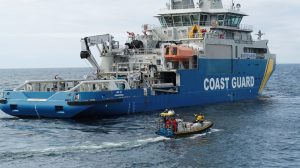Preparations & Issues to Consider before and during Boarding


Before we start, we want to emphasize that occupational safety is one of the utmost important factors in a search and rescue mission. The SMC has to take it into account, but also the leaders of the SRUs have to consider what are the possibilities for the rescue personnel to work safely. Otherwise, it can happen that the rescuers become the ones to be rescued.

How to prepare to board?
When planning the boarding, remember to consider the following issues:
- What are the possible escape ways for the rescue personnel to use to evacuate from the accident scene if needed?
- What Personnel Protective Equipment is needed, and how does this affect the working time in the actual accident scene?
- What is the safest direction to approach the distress vessel from?
Remember, once again, as the SMC, you can – and you should – consult the master of the DV, HNS experts and other authorities for collecting information and making decisions.
You as the SMC have to prepare an action plan. What elements should it contain? Pick the right alternatives:
Tasks of the units:
- Current situation at the distress vessel
- Risk assessment
- Communication channels and means
- Information of the weather and other circumstances
- Information of the needed PPE and other safety equipment (such as?)
- Use of detection and measurement devices
Yes, as you realized, all of the above should be mentioned in the action plan.
Are we ready now – just start boarding? No, let’s consider a few more issues.
How to decide on the transportation to the distress vessel?
Once again, as SMC, you should remind yourself of the decision making cycle:

The information of the HNS in question, how does it react, or what are the possible hazards it might cause, are the key issues at this stage. Below we have mentioned just a few things that you also need to consider:
- Using helicopter might be impossible due to HNS vapors or gas cloud
- Also weather conditions and a long distance may restrict the use of a helicopter
- Needed capabilities might be limited in order to do the actual boarding
- Can the distress vessel anchor or be towed?
Is it safe to board? Good, then we can continue but before that remember:
Everyone taking part in the actual rescue operation onboard the distressed vessel needs to be registered! This is one of the occupational safety issues, and through registering, the working time can be estimated, and for how long have the rescuers have spent in the hot zone
What are the issues to consider before and during the actual boarding to stay safe?
The master of the distress vessels needs to be consulted before all the action taking place within the vessel.
You as the master of the search and rescue unit have to prepare the boarding team, entry team and the back up team on occupational safety, and decide whether it is safe enough to actually enter the distress vessel.
You also have to decide the safest point for the entry of your team, and to do this in co-operation with the master of the distressed vessel, be it from a helicopter or from the rescue vessel. If the crew of the distressed vessel is not able to assist, also maneuvering the rescue unit alongside the distress vessel is an option, and, for example, using a crane for boarding.

Then make a plan of the procedure:
- How to board?
- Double check that the registration process is at place
- Is the unit aware of your guidance?
- Are the decontamination places and first response facilities at place and double checked to work properly?
- Do you have enough right breathing equipment so that the possible victims can be evacuated, and the rescue team has reserve air?
What have you learned in this section?
- Consider if it is even possible to board to the distress vessel, or will it cause too big of a risk for the rescue personnel.
- Approaching the distress vessel may contain several challenges.
- Prepare a detailed action plan as the SMC, after consulting the other actors; and as a master of the SRU, plan a detailed procedure on boarding the distress vessel.
